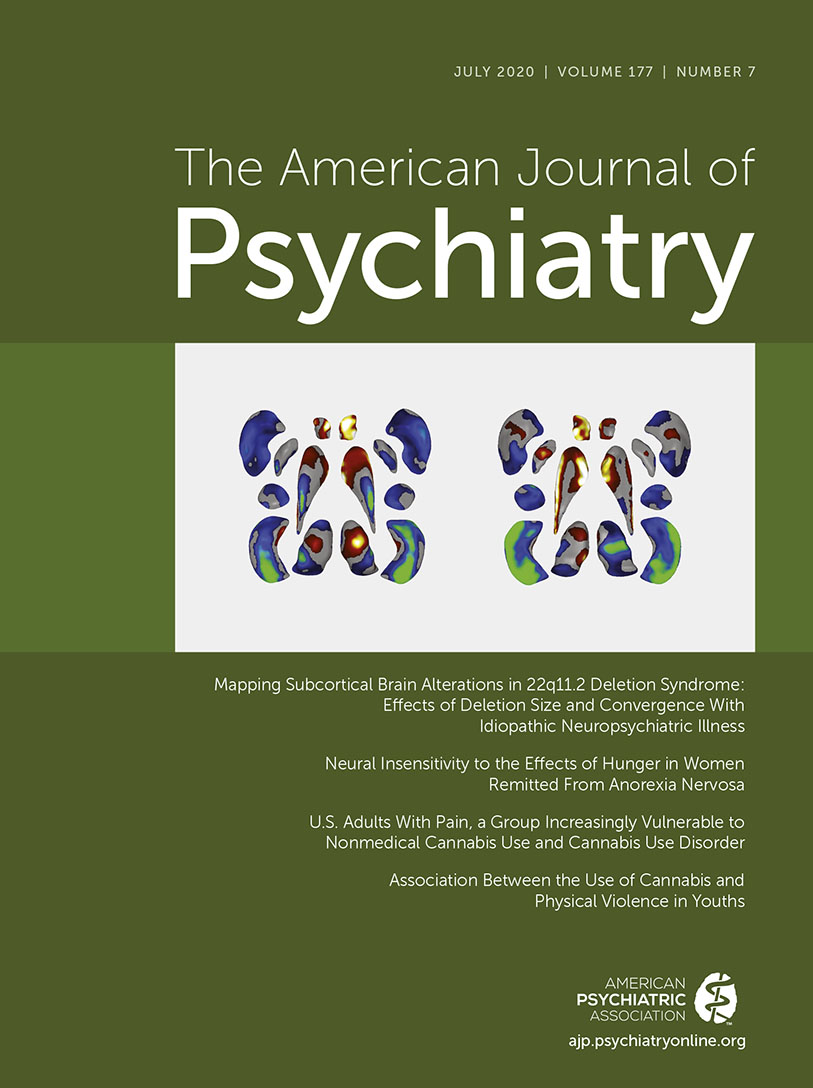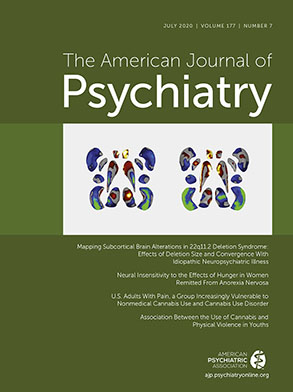In an article in this issue of the
Journal, Hasin and colleagues (
1) used data from the National Epidemiologic Survey on Alcohol and Related Conditions to examine differences in the prevalence of nonmedical cannabis use and cannabis use disorder in U.S. adults with and without pain over the period between the early 2000s and 2012–2013. In the early 2000s, the prevalence of frequent cannabis use did not differ by pain status, whereas in the 2012–2013 survey, there was a higher prevalence of nonmedical cannabis use among individuals with pain (5.03% compared with 3.45%), suggesting an increase in cannabis use to treat pain during this period. In both surveys, cannabis use disorder was more prevalent among those with than without pain, but there was a significantly greater risk differential in the later survey.
This article brings attention to the intersection of two critical current issues in addictions in the United States: confusion around medical uses of cannabinoids and the opioid crisis. The legal status of cannabinoids has been rapidly evolving since the late 1990s, when medical marijuana was first approved and dispensaries were established in a legal “gray zone” in Washington state. Since that time, many states have legalized medical marijuana, and states that were early adopters of medical marijuana have now legalized recreational marijuana use by adults. As of January 2020, medical marijuana is legal in 34 states, and in 11 of these, recreational use by adults is also legal. While the states took action, the use and possession of cannabis has remained illegal under federal law via the Controlled Substances Act of 1970. To date, the U.S. Food and Drug Administration (FDA) has not approved a marketing application for cannabis for the treatment of any disease or condition. The agency has, however, approved one cannabis-derived drug product—Epidiolex (cannabidiol; CBD)—and three synthetic cannabis-related drug products.
In spite of this contradiction between state and federal regulations, when substances become legal, they are more readily available and are generally viewed as less risky and more socially acceptable (
2), so it is no surprise that the prevalence of cannabis use and cannabis use disorder in the United States has been steadily increasing since the early 2000s, with 22% of individuals ages 18–25 endorsing past-month use in 2018 (
3). Having state legislatures make decisions about what is considered “medical” without requiring scientific evidence has left the medical community in the difficult position of dealing with the “fallout” from the promotion of marijuana and other cannabinoid products for a wide variety of disorders with very little evidence of efficacy. Marijuana consists of over 200 cannabinoids in varying quantities, depending on the strain/varietal. Many of these cannabinoids have their own potential medicinal properties. Some, like CBD, can actually antagonize some of the effects of other cannabinoids, so one can’t be sure what percentage of which cannabinoid is being smoked or ingested. The National Academies of Science (
4) commissioned a report on the health effects of cannabinoids, which concluded that there was substantial evidence for the use of cannabis or cannabinoids in chronic pain, but warned that the study methodologies were flawed and that the quantity, quality, and type of cannabis product varied considerably between studies and laboratories. There were other areas in which the authors of the report felt that exploration of medical uses of cannabinoids would be useful, but only if methodologic barriers could be overcome. The report also made it clear that there can be downsides to marijuana use, including cognitive difficulties and the development of dependence.
FDA standards for approving and marketing medications in the United States include careful, blinded studies with known doses of the compound designed to determine dosage, side effects, and long-term consequences. The drug approval process takes place within a structured framework including analysis of the target condition and available treatments, assessment of benefits and risks from clinical data, and strategies for mitigating risks. Risk management strategies include an FDA-approved label, which clearly describes the drug’s benefits and risks and how the risks can be detected and managed. If more effort is needed to manage risks, a Risk Management and Mitigation Strategy developed and implemented by the pharmaceutical company may be required. Caregivers and patients can be confident that FDA-approved drugs have been evaluated for safety, efficacy, and quality and are monitored by the FDA once they are on the market. Until there is more careful investigation of potential medicinal uses of cannabis as well as side effects and long-term consequences, how can these products be considered “medicinal” in a country that has such an extensive regulatory system to manage medications? The FDA has issued warning letters to a number of companies for aggressive marketing of cannabinoid products for therapeutic uses or as dietary supplements and issued a revised Consumer Update detailing safety concerns (
5), but has made no other attempts to regulate the cannabis market. As a physician who treats many of the conditions for which cannabinoids are touted as treatments, I would prefer that a primarily recreational product with clear abuse and dependence potential not be confused with a medicine. The medicinal benefits of medical marijuana and cannabinoids should be evaluated by the same standards we apply to every other medication before being prescribed or recommended by physicians and advertised to the public.
The opioid epidemic, which the United States finally seems to be pulling out of, was largely initiated because many Americans seek treatment for chronic pain, and treatment options are limited. The treatment of chronic pain is another area in which research is sorely lacking. An analysis of National Health Interview Survey data found that an estimated 20% (50.0 million) of U.S. adults had chronic pain and 8.0% (19.6 million) had high-impact chronic pain (
6). The opioid crisis began with the overprescription of opioid analgesics for pain, but it expanded to the use of heroin and illicit synthetic high-potency opioids as regulatory agencies and physicians began to limit opioid prescriptions (
7). In the context of increasing availability and health claims about medical marijuana, the use of medical marijuana and other cannabinoids to treat pain is understandable and is a much safer option. The problem is that there is no quality control of the product, no reliable evidence of efficacy, and no warnings about side effects or long-term consequences to allow careful deliberation about the risk-benefit ratio. Rigorous exploration of the use of cannabinoids and other alternatives in the treatment of pain is needed. The National Institutes of Health (NIH) has responded to this need through a trans-NIH initiative, Helping to End Addiction Long-Term (HEAL), focused on improving treatments for opioid use disorder and enhancing strategies for pain management (
8), which includes funds dedicated to the identification of new targets and preclinical testing platforms as well as a pain-focused clinical trials network. While there will be no quick solutions, these initiatives offer hope in addressing these pressing issues.
The bottom line is that cannabinoids have shown promise in the treatment of chronic pain, but more evidence is required. There are risks involved with the chronic use of cannabinoids, including the risk of developing cannabis use disorder, clearly demonstrated in the study by Hasin et al. A recent meta-analysis emphasized that cannabis withdrawal syndrome is uncomfortable and clinically significant in almost 50% of chronic cannabis users (
9). While lethality with cannabinoids isn’t the critical issue it is with the opioids, when physicians prescribe medications, the standard of care is a full accounting of risks and benefits. Our experience with the opioids should serve as a warning about how important this can be. Shouldn’t we study the medicinal potential of cannabinoids with the same rigor on dosing, purity, chemical specificity, and risk-benefit ratio that we use for other agents that we call medicines? The United States has the most expensive health care industry in the world, a sophisticated pharmaceutical industry, and expensive regulatory systems. In this context, don’t the people of the United States deserve better?

